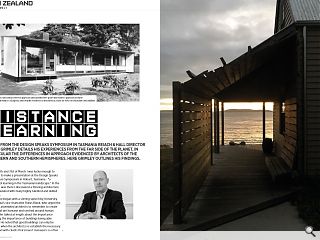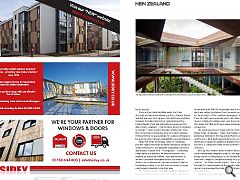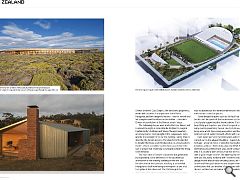New Zealand: Distance Learning
10 Jul 2019
Fresh from the design speaks symposium in Tasmania Reiach & Hall director James Grimley details his experiences from the far side of the planet, in particular the differences in approach evidenced by architects of the northern and southern hemispheres.
On the 30th and 31st of March I was lucky enough to be invited to make a presentation at the Design Speaks Architecture Symposium in Hobart, Tasmania - “a weekend of learning in the Tasmanian landscape.” In the few days I was there I discovered a thriving architecture scene populated with many highly talented and skilled architects.
Day one began with a stirring speech by University of Tasmania’s vice chancellor Rufus Black, who urged the 300 or so assembled architects to remember to create spaces that are humane and centred around human activity – he talked at length about the importance of bathing, the importance of buildings being able to breath. He noted that good buildings can only be produced when the architects re-establish the necessary direct bond with clients that project managers so often try to obscure. Six practices presented their work, four from Australia and two international practices of which Reiach and Hall was one. First up were Peta Heffernan and Elvio Brianese, founding directors of Tasmanian practice - Liminal Studio.
Their talk started by focussing on ‘the dinner party epiphany’ – that moment when the meaning of a project comes to light through conversation. They then presented a fascinating array of projects ranging from performance spaces/props for a dance company, to bespoke furniture designs and skilfully conceived houses. Next, Mat Hinds and Poppy Taylor of Tasmanian practice Taylor and Hinds Architects showed a variety of small scale projects including the exquisitely conceived and detailed krakani-lumi - ‘resting place’ - a standing camp within the wukalina/Mt William National Park. Inspired by traditional Palawa - half-domed forms of ancient Tasmanian Aboriginal shelter, the series of shelters are as unusual are they are beautiful. It will be fascinating exciting to see the practice evolve as larger commissions hopefully come their way. The morning session concluded with my talk about Reiach and Hall Architects, tracing threads and themes in our work from 1944 to the present day. Our northern work was distinctly different from the works presented by the architects of the southern hemisphere. Works from the south were generally rural, fully timber lined spaces, framing incredible views over the landscape.
Our works from the north were spare and modest by comparison. The afternoon session began with Jad Silvester and Penny Fuller, of Silvester + Fuller from Sydney. Having previously worked for Herzog and de Meuron and Foster and Partners, their work was polished and conceptually driven and included an ambitious holiday resort fit for the set of a James Bond Film on the northern coast of Tasmania. Next up was Andrew Burns Architect who presented some conceptually delightful projects, the high lights being a series of hiking lodges in the Tasman National Park and a delightful competition entry for a sports scheme - The Green Square Aquatic Centre - generated through the transformation of the simple cricket fence into an oval envelope that rises and falls around a variety of sports spaces.
The final presentation was an inspirational talk by the Chilean architect Cazú Zegers. She discussed geopoetics, works with students, the impressive Hotel Tierra Patagonia, and two delightful houses – one for herself and her daughter and the other for her mother – a modern Chilean interpretation of the Roman atrium house. The following day we were invited to have dinner and to spend the night at John Wardle Architect’s magical Captain Kelly’s Cottage and Sheep Shearers quarters on Bruny Island. The highlight of the symposium, John Wardle hosted eight of us for the evening, taking time to describe the design process, the objects he’d collected to inhabit the house and introduced us to a local eastern Quoll – a black and white spotted marsupial about the size of a hare that fearlessly scavenged outside the living room window. The roof form of Shearer’s Quarters was generated by responding to the difference in the geometrical orientation of the existing building on the site and the direction of the contours, resulting in a roof that triangulates itself from being a monopitch at one end to a gable at the other end. The 700mm grid that determined the interior cladding of Pinus Macrocarpa, was established as the minimum dimension into which an internal door could be placed. Some delightful quirks such as the fact that some books can’t be taken off the bookshelves as they are structurally supporting the shelves above.
The building is beautifully put together and a treat to spend a jet-lagged early morning watching the sun rise from its east facing living area whilst discussing geopoetics and the works of Scottish French author Kenneth White with Cazú Zegers. Even more special is the restoration and remodelling carried out to the adjacent building - Captain Kelly’s Cottage - a tour de force of selective restoration and inventive addition. The building won the RIBA Award for International Excellence last year, and it’s easy to see why. It is clearly a work of love, that has been carried out over a good length of time. The layering and blending of new and old, richly textured with inventive detailing and design moves that should certainly satisfy the Tasmanian University Principal’s desire to see people centred architecture that can breathe. A wonderful setting to discuss architecture and drink Tasmanian whisky late into the night.
|
|





